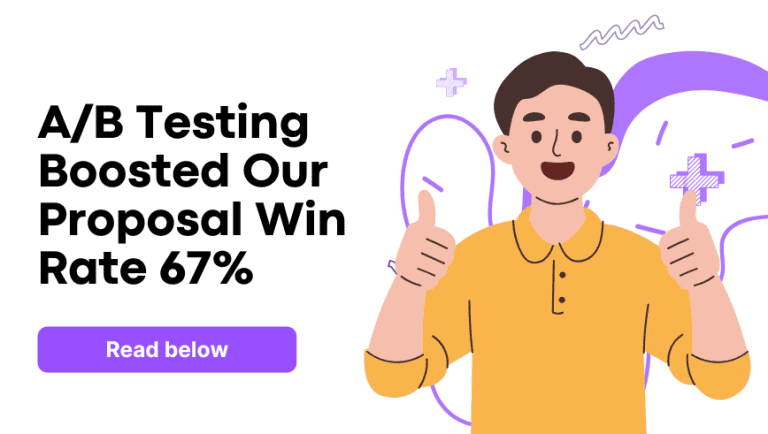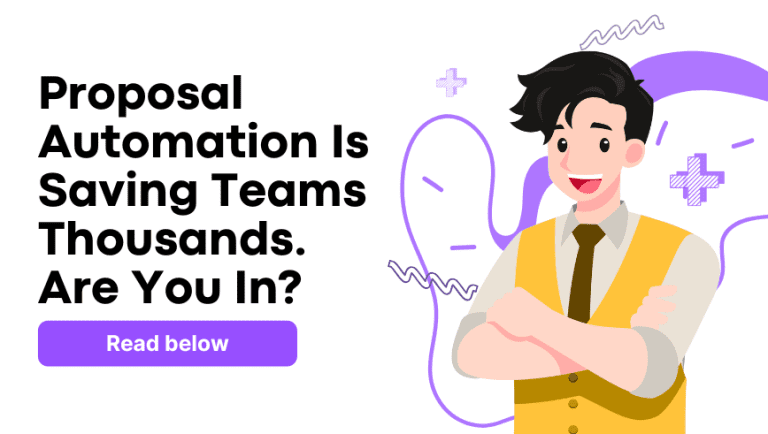“Their offer was cheaper.”
It’s the sentence no one wants to hear after a pitch. All the effort, strategy, and time, gone because someone else came in with a lower number.
We’ve all been there.
You spend hours crafting the perfect proposal: clear objectives, a compelling offer, a competitive edge. And yet, the reply is short: “Thanks, but we went with a cheaper option.” It stings. Not because you lost the deal, but because you know your solution was better. It just didn’t land.
That’s where value-based selling comes in. It shifts the focus from what you do to what it’s worth to the client. Instead of listing features or deliverables, it emphasizes outcomes: growth, time saved, risks avoided, and revenue gained. It’s not about convincing someone you’re affordable. It’s about making them see you as essential.
When done right, this approach not only makes your proposals stronger, it also makes your positioning unshakeable. Clients stop asking “how much?” and start asking “how soon?” This blog unpacks how to move beyond the pricing trap and shape a sales proposal strategy that frames every word around client value. If you’ve ever felt undercut by a lower quote despite having the better offer, this is for you.
Because in most deals, it’s not the cheapest that wins. It’s the clearest, the most confident, and the one that proves its worth upfront.
At Proposal.biz, we’ve seen this happen across industries. From SaaS to consulting, teams pour heart and logic into proposals, only to be ghosted or outbid. It’s not because the service lacked substance. It’s because the proposal didn’t communicate value.
This is where value-based selling changes the game.
Why Price Isn’t the Real Objection
When businesses say price is the issue, it usually isn’t. It’s a placeholder for “I don’t see why it’s worth more.”
And if your proposal doesn’t spell that out, the reader fills the blanks with assumptions, usually wrong ones.
We’re not here to chase the cheapest bid. We’re here to help you write proposals that get chosen because they deserve to be.
The Psychology Behind Value-Based Selling
In a world full of “quick quotes,” businesses crave clarity, confidence, and commitment. A proposal built using a value-based selling methodology speaks to these directly.
Clients rarely want the cheapest. They want the safest choice. The most logical ROI. The partner who understands the risk of getting it wrong and the reward of getting it right.
That’s why the value selling framework isn’t just a pricing strategy. It’s a communication strategy.
Your Proposal Is Your Salesperson
Before anyone gets on a call or signs a deal, they read. They scan your proposal while juggling three tabs and a Slack ping.
So, let’s say it plainly: if your proposal doesn’t make them feel something valuable, they’ll click elsewhere.
What you write is your voice when you’re not in the room. A strong sales proposal strategy turns features into outcomes and numbers into narratives.
Inside a Value-Based Proposal
No matter the type of business proposal, here’s what most proposals do:
- List deliverables
- Add timelines
- Drop a price
Here’s what a value-based selling proposal does:
- Aligns with business objectives
- Quantifies opportunity cost
- Frames pricing in the context of gain, not spend
- Personalizes benefits
- Supports all of this with proof
Let’s look at a short example.
Option A: “SEO services – 6 months – $5,000”
Option B: “6-month SEO sprint designed to grow inbound leads by 70%+, built on the same structure we used to help [X company] go from 4 to 22 monthly demo calls. $5,000.”
Same deliverable. One price feels like a number. The other feels like an investment. This is all it takes to truly fix your entire sales cycle.
Negotiating Without Lowering Price
A common fear: “What if they ask for a discount?”
A confident value-based selling methodology prepares you for this. If your proposal has built the case well, here’s how you can shift the conversation:
- Instead of lowering price, reduce scope.
- Reframe cost as the smallest part of a larger gain.
- Highlight risk avoidance: “Choosing a cheaper CRM sounds efficient, until data migration breaks during rollout.”
It’s not being pushy. It’s being professional. You have highlighted the things to be considered when choosing a CRM. You’re helping the client make a decision they won’t regret.
Building Trust Without Saying ‘Trust Us’
Trust doesn’t come from how often you say “we care.” It comes from details that show you’ve thought about them.
When we built Proposal.biz, we spoke to founders, account managers, and sales teams who were tired of templates that looked slick but didn’t sell. They needed a tool that could generate proposals not just faster, but smarter.
That’s why our one-of-a-kind AI proposal creation platform is driven by real-time insights, layered with brand-safe logic, and designed with multi-industry compatibility.
No two businesses are the same. So no two proposals should sound the same.
A New Breed of Proposal Tools
Here’s the truth: most tools in the market offer either beautiful design or basic automation. Not both.
Proposal.biz is being built to give you:
- Fully generated, editable proposals
- Client-specific personalization pulled from CRM or web data
- Smart layout logic that adjusts to your industry
- Reusable success metrics you can plug into proposals
- Review intelligence that shows where prospects are pausing
It’s not just AI-assisted. It’s value-based selling, embedded into your proposal flow. This is the kind of automation all SMEs need to incorporate in their sales strategy.
Why ROI Wins Over Discounts
Clients don’t get excited about saving $₹10,000. They get excited when you help them earn $₹1,00,000 more. Or save 40 hours. Or onboard 50 clients faster.
Every feature in your proposal should have a line under it: “So what?” If you can answer that with a value outcome, you’re doing it right.
Let’s say you’re offering a cloud migration service. Don’t say:
“We’ll migrate your infrastructure in 8 weeks.”
Instead say:
“You’ll go from $10k/month in server maintenance to $2K/month post-migration with zero downtime risk.”
That’s value-based selling in motion.
The Framework We Follow
Every structure in both our pre-built templates and AI proposal generator follows a version of the value selling framework, broken down as:

- Understand Business Pain
Get clear on what the client loses by not choosing you. Time, money, credibility? - Map Features to Goals
Each line item must link to a measurable or emotional benefit. - Layer in Proof
Case studies, data points, or industry benchmarks—use them to reinforce the value. - Price in Context
Anchor your proposal with the cost of alternatives. What happens if they choose the wrong vendor? - Make Saying Yes Easy
Use smart formatting, clear milestones, and frictionless next steps.
This is the value-based selling methodology Proposal.biz follows internally and powers externally.
How to Stop Losing to Cheaper Competitors
Lower-priced competitors will always exist. But what they can’t beat is clarity.
When your proposal:
- Speaks to the real business case
- Offers tangible ROI
- Shows proof without jargon
- Anticipates objections
- Feels like it was made just for that client
Then you’re not negotiating anymore. You’re leading.
And when that happens, even the lower bidder becomes irrelevant. This is an imperative step when conducting sales analysis.
Proposal Metrics That Matter
Here are the 3 key metrics we bake into every proposal generated through Proposal.biz:
- Proposal-to-meeting conversion went from 12% to 38%
- Average client close time dropped from 21 days to 9 days
- Discount requests per proposal reduced from 35% to 10%
Each number tells a story. Not about pricing. About perception.
When clients feel value, they rarely ask to pay less.
Write Proposals That Sell Outcomes, Not Just Services
Writing a proposal using value-based selling isn’t about listing what you offer. It’s about showing why it matters.
Buyers don’t read proposals like a checklist. Proposal reading psychology shows they skim for one thing: outcomes. That’s why each section should answer: What will this do for them?
Instead of saying: “We conduct quarterly audits and submit compliance reports.”
Say: “Our quarterly audits reduce your compliance risk and help you avoid potential penalties of up to $5k.”
This subtle change shifts the focus from activity to impact. It also improves proposal clarity, especially when decision-makers are scanning for business value.
Tips to implement value-based writing in your proposals:
- Add a “Why it matters” subtext under every major deliverable
- Tie services to a metric: cost saved, time saved, risk avoided, leads generated
- Open your executive summary with pain point > solution > result
- Use real outcomes or mini case examples if available
This approach increases recall, strengthens your perceived value, and keeps readers engaged, especially on the first three pages where 81% of attention lives.
Negotiating Without Lowering Price: Value-Based Selling Tactics That Work
When clients request a discount, it’s often not about the actual number, it’s about perceived value. A proposal aligned with value-based selling helps you negotiate confidently while preserving margin.
Here’s how:
Instead of dropping your price, restructure how the value is presented. For example: “At $800/month, this includes automation + reporting + support. But if your current need is only automation, we can offer a limited $500/month version.”
This shows flexibility without devaluing the offer.
Tips to handle pricing objections in proposals:
- Include tiered options on page 2 to anchor value early
- Add a short “What’s at stake?” or “Cost of inaction” section
- Include ROI estimates or outcome-based stats to shift focus from cost to return
- Keep your high-value differentiators visible on every tier
By pre-empting price discussions and structuring choice, you stay in control of the narrative. Clients feel empowered, not pressured and that increases close rates without cutting your worth.
Checklist: How to Build a Value-Based Proposal That Wins Deals
- Identify and understand the client’s core pain points
- Map every feature or service to a tangible business goal
- Include proof points or results from similar past clients
- Frame pricing as a return and not a spend
- Use clear formatting and direct, confident language
- Highlight risk avoidance and strategic gain
- Personalize the proposal to the client’s industry and stage
- End with simple next steps and zero ambiguity
Communicating Value Over Price
Proposals grounded in value-based selling speak to the client’s goals, while traditional ones focus on services and timelines. A value-driven proposal shows how your solution will transform their operations, reduce losses, or increase gains.
Instead of saying: “We offer monthly compliance reports.”
You could say: “We help reduce audit penalties by catching compliance gaps early, saving teams up to ₹3L per incident.”
Interestingly, this is where AI tools have shown real promise. A research study found that proposals using AI-assisted value framing achieved a 34% higher engagement rate compared to traditional templates
This supports what proposal reading psychology already proves: readers engage more when value is framed as results they care about, not tasks they plan to complete.
Frequently Asked Questions
What is value-based selling in proposals?
Value-based selling in proposals focuses on the return a client receives rather than just deliverables. It positions the service as a solution tied directly to client goals, making pricing easier to justify.
How do I justify higher pricing in a proposal?
You justify higher pricing by clearly linking your service to outcomes, showing ROI, sharing proof points, and framing the cost as an investment rather than an expense.
What is the difference between value selling and traditional sales?
Traditional sales often focus on features and prices. Value selling aligns every offer with the client’s pain points, quantifying the impact and making outcomes the center of the pitch.
Can AI tools support value-based selling frameworks?
Yes. AI tools like Proposal.biz support value-based selling by automating personalization, quantifying ROI, and ensuring every proposal speaks to client-specific goals and risks.
How do I negotiate without lowering my price?
Instead of discounting, reduce scope or reframe your proposal to show the cost of inaction. Reinforce your unique value and explain what the client gains, not what they’re paying.
Let’s Talk About Real Proposal Business Value
We didn’t build Proposal.biz to win at beauty. We built it to win at business. And that’s why we aim to provide the flexibility each industry needs for their use cases, all the while making the process simple by leveraging AI.
In an age where client attention is fragmented, your proposal can’t just be informative. It must be persuasive. Personal. Precise. And always framed around the value you bring.
This is what value-based selling means to us. And this is what we’re building into every click, every proposal template, and every automation inside Proposal.biz.
If you’re someone who’s tired of lowering prices, of explaining your worth over and over, of losing to proposals that only cost less but offer less too. Join our waiting list.
We’re not ready yet. But we’re building this for you. Your help will make us just that much better at serving you.
Let’s sell value, not just price.




